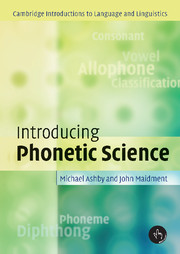11 - Speaker and hearer
Published online by Cambridge University Press: 05 June 2012
Summary
CHAPTER OUTLINE
In this chapter you will learn about: the human hearing mechanism; the use of visual clues in speech perception; speech perception tests – labelling and discrimination; speech development in children; hearing impairment.
KEY TERMS
Acoustic cue
Audiogram
Categorical perception
Cochlea
Cue redundancy
Discrimination
Labelling
Introduction
This book has concentrated largely on how human beings produce speech and how speech sounds are organised in languages of the world. However, we usually speak for the purpose of communicating with others who must receive the acoustic signal created by movements of the speech organs. This signal must be decoded and then understood by the hearer. We begin the chapter by looking at the hearing mechanism and the supplementary use of visual cues to aid speech perception. We then describe the methods used to investigate which aspects of the acoustic signal are important for the perception of phonetic distinctions. Phoneticians are not only interested in how speech is produced by the speech organs and the acoustic properties of speech sounds, but also in how human beings receive and process the speech signal. The study of speech perception is one of the major applications of phonetics. Speech perception tests involving labelling and discrimination tasks with synthetic speech stimuli have been used in many areas of research and we look briefly at some of these, including cross-language comparison of acoustic cue perception. Next we look at the development of speech perception and production in children. The chapter concludes with an account of the ways in which hearing impairment may interfere with the perception of speech.
- Type
- Chapter
- Information
- Introducing Phonetic Science , pp. 177 - 188Publisher: Cambridge University PressPrint publication year: 2005



